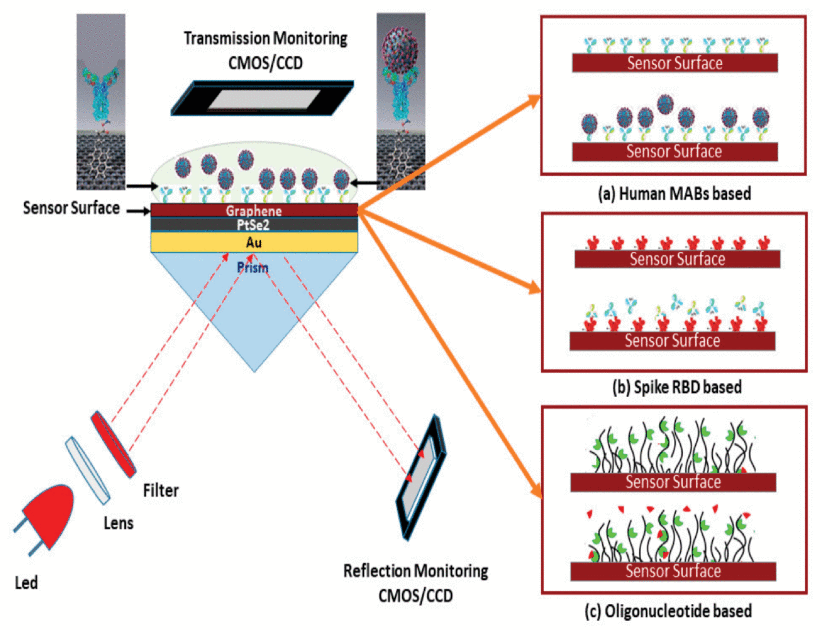SPR Based Biosensing Chip for COVID-19 Diagnosis-A Review
The severe acute respiratory syndrome coronavirus 2 (SARS-CoV-2) or COVID-19 severely impacts human health and lives. As COVID-19 was declared a Global pandemic, the primary focus shifted to swift and accurate detection methods to contain and combat the rapid spread of SARS-CoV-2, the virus responsible for the COVID-19 pandemic.
Prevalent methods like thermal screening guns, enzyme-linked immunosorbent assay (ELISA)-based immunoassays, and real-time reverse transcriptase polymerase chain reaction (RT-PCR) have drawbacks like high costs, lack of specificity, and prolonged testing periods.
Surface plasmon resonance (SPR) technology, a powerful biosensing method, has been utilized for decades for detecting biomolecules such as blood group measurement and adulteration in milk and other food items.
The use of SPR sensors for quick and accurate diagnosis of the SARS-CoV-2 virus has gained attention due to their ability to perform dynamic and sensitive monitoring of ligand-analyte binding interactions.
The paper presents an exhaustive review of existing biosensor-based state-of-the-art diagnostic methodologies for viral infections. The study lays the foundation for the development of versatile virus biosensors in the future.
The Surface plasmon resonance (SPR) technology provides real-time, label-free information on light-matter interactions at a metal-dielectric interface. It monitors chemical and biological parameters by monitoring the changes in the refractive index (RI). Using total internal reflection (TIR), the sensor detects real-time ligand-analyte immobilization in the detection area.
SPR sensor requires a coupling medium, such as grating waveguides, high index prisms, or optical fibers. A sensing chip is fabricated as a multi-layered structure spin-coated with high refractive index glass works as one surface of an SPR prism. The change in RI due to the concentration of virus protein is measured as a change in the angle of light ray. The concentration of biomolecules affects the refractive index of the sensing area, influencing the excitation of surface plasmon polaritons (SPPs) in the multilayer sensor interface.
A highly sensitive SPR biosensor coated with graphene-based multiple layers (BK7/Au/PtSe2/Graphene) was used for coronavirus detection. The sensor's performance was numerically investigated using the transfer matrix method (TMM) and finite-difference time-domain (FDTD) approaches. The sensor displayed a sensitivity of 183.3◦/RIU, much superior to the commonly used conventional sensors.
Another effective strategy for diagnosing COVID-19 combines the plasmonic photothermal (PPT) effect with the localized surface plasmon resonance (LSPR) sensing transduction. Gold nano-islands (AuNIs) functionalized with complementary DNA receptors are utilized to detect specific sequences from SARS-CoV-2 with high sensitivity.
A study on the barley stripe mosaic virus-infected plants found that RNA-binding agents were more effective than gold sheets. The N protein of the virus binds to RNA and facilitates the binding of additional domains to the protein. Aptasensors, utilizing short single-stranded DNA or RNA molecules (aptamers), are used to detect specific target molecules, such as the receptor-binding domain (RBD) of the SARS-CoV-2 spike glycoprotein.
Scientists aim to develop more efficient SARS-CoV-2 detection methods by combining knowledge of nanomaterial interactions with nucleic acids, antibodies, and advanced optical diagnostic tools. SPR-based biosensors, including chimeric SARS-CoV-2 and SARS 2 RBDs for ACE2 restraints, represent promising avenues for further research and development.




